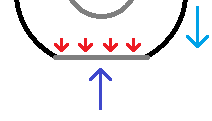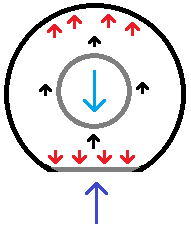How do air-filled tires work? Obviously the inside of the tire is filled with air, which exerts pressure on all surfaces of the tire. However since pressure does not have any particular direction, why does the rim not fall through to touch the ground? In other words, how does air under uniform pressure transmit a directional force from the ground to the rim?

Visual representation of the question. Red and green arrows represent air pressure while the blue arrow represents vehicle weight.
First, we will consider the tire-ground contact interface. The force that the tire can exert on the ground is based on two factors: the contact area of the tire that transmits air pressure forces to the ground, and the bending of the tire's rubber surface which creates an upward elastic force tending to restore the tire's curvature. As can be readily confirmed with underinflated bike tires, the second effect is only significant when the air pressure in the tire is very low, and in this case the tire is not usable. Thus while the second effect always exists, during regular tire use it is overshadowed by the first. Thus to a good approximation, the force that the tire exerts on the ground is equal to the contact area * tire pressure. Assuming that the vehicle weight remains constant, it is then an interesting conclusion that the tire pressure can be approximated by observing the tire's contact area with the ground. Since a larger contact area tends to bend the rubber nearest the ground surface, the appearance of a flat tire is distinctly different from a filled tire.

Visual representation of the tire-ground contact. Red arrows represent air pressure, the light blue arrow represents vehicle weight, and the dark blue arrow is the opposing force from the ground.
Assuming a bicycle+rider weight of 200 pounds, and tire pressure of 40 psi, 5 square inches are in contact with the ground. Note that due to the tire's design (which may have treads for better grip) the actual area touching the ground may be less than the estimate above, but the area of the inner tube that is able to transfer force to the ground is still the number given by the above formula. If pressure in the tire drops or weight of vehicle increases, the contact area will also increase. An increased contact area means better grip for the tire, but also lower vehicle efficiency since the bending of the tire around the contact area is a process that dissipates energy. Thus ensuring car tires are at an appropriate pressure can have an observable effect on fuel economy, but if the car is expected to travel through difficult terrain it may be worthwhile to decrease the tire pressure.
Having considered the ground interface, we need to see how the force is transmitted from the tire to the rim, or at the tire-rim interface. For this, we will start the consideration with a tire having an inner tube. An inner tube may be assumed to provide a way of having different forces on different areas of the rim. Thus perhaps the inner tube moves around the rim such that the contact area of the rim at the bottom is higher than that at the top. Otherwise, since pressure at the top and bottom are the same (pressure is a uniform property, and there are no divisions within the tire) there should be no net force on the rim.

The tube (light gray) may move around the hub (dark gray) causing the vehicle weight to be transmitted to the tire.
The above might contribute to the action of inner tube tires, but tires without inner tubes certainly exist. How do they work? There still must be a difference in contact area, however this difference is not experienced by the rim but rather by the inner surface of the tire itself. While the bottom portion is in contact with the ground, any forces generated by the air pressure in that area are transferred directly to the ground and not to the tire surface. This is to be contrasted with all other areas of the tire (not touching the ground), where the pressure of the air is counteracted by the tire's elastic force. For instance, air hitting the inside of the right surface of the tire tends to push the tire to the right (causing it to maintain the characteristic 'filled tire' appearance) however the tire does not move to the right because this force is countered by the same tendency on the left side of the tire. Once the tire touches the ground however, the symmetry of internal forces is upser with the area on top of the tire exerting a force that is not counteracted by the area on the bottom of the tire (but rather by the ground). Thus the force that the vehicle's weight exerts is transmitted to the tire material itself before being transmitted to the ground. The only way for this force to be transmitted in conventional tires is through the area where the tire's rubber material is in direct contact with the rim, since in other areas only the uniform air pressure exists. With some consideration, it may be seen that this effect is also a major contributor in the functioning of tires containing inner tubes.

The vehicle weight (light blue arrow) is transmitted through the rim to the rubber material in the tire (black arrows), which in turn transfers the weight through the top of the tire into the air (upward red arrows). The bottom of the tire is deformed and transfers the weight from the air (downward red arrows) to the ground (dark blue arrow).
Therefore, the force is transmitted from the tire to the rim through the metal-rubber direct contact areas of the tire, rather than other parts of the rim surface. Since the metal-rubber contact can transmit forces in any direction, the upward force tends to be spread throughout the entire rim-tire surface contact area rather than concentrated at any one point as it is within the tire itself. This analysis suggests that tires for heavy loads should be very stiff and have increased metal-rubber contact area to effectively transmit forces.